On Monday, the American Association of State Highway Transportation Officials (AASHTO) — an influential group of state DOT directors — announced a report calling on Congress to prioritize funding for expanded rural highway capacity in the forthcoming re-write of the transportation bill. Spending hundreds of billions on highway projects and adding 30,000 new lane miles is sure to raise eyebrows in active transportation circles, but could AASHTO’s plan help improve biking conditions on highways across America?
Maybe.
“It could be be a boon to the USBRS [United State Bike Route System], it all lies in the implementation.”
— Ginny Sullivan, Adventure Cycling
In a statement about the new report, AASHTO Executive Director John Horsley says, “Improving connectivity for the 60 million Americans who live in rural areas is just as important as improving mobility for those who live in metropolitan areas.” Key to Horsley’s argument is that most interstate highways were built 60 years ago, and little has been done to improve or expand capacity on them since.
Here’s more from Horsley:
“… investment is needed in America’s rural transportation system to keep agriculture, new energy products and freight moving; improve access for the travel, recreation, and tourism industries; connect new and emerging cities; and to ensure reliable access to key defense installations.”
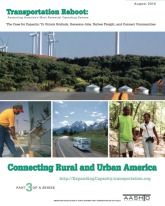
– Download here –
Specifically, AASHTO wants the US highway program to be increased to $375 billion over six years and they are calling for 30,000 new highway lane miles. The report also provided a state-by-state list of highway projects. For Oregon, the report singled out the controversial, $550 million dollar Newberg-Dundee Bypass project (which scored a $192 million earmark from lawmakers in Salem last session).
While the report has enough talk of more and bigger highways to make active transportation advocates cringe, it also advocates for rural transit service to “more than double over the next six years to keep pace with rising demand.” There’s also the question of how bicycling could benefit with smoother, wider shoulders, and more space on bridges and roads.
Given AASHTO’s support of Adventure Cycling’s U.S. Bicycle Route System, and Mr. Horsley’s familiarity with bicycling in general (he keynoted the National Bike Summit in 2008), I asked Adventure Cycling’s Ginny Sullivan if she thought AASHTO’s desires could benefit bicycling.
“It could be a boon to the USBRS,” she said, “it all lies in the implementation.”
Sullivan says the USBRS and a push for higher quality rural interstate roads share a “common goal” of linking developing with scenic destinations. Here’s more from Sullivan:
“If implementation of this rural road/highway system includes adding or expanding shoulders that are protected from in appropriate rumble stripping, then yes, this push is beneficial. I also see the potential for overcoming other barriers, such as widening bridges to accommodate bicycle passage safely and conveniently. As we both know, adding vehicular capacity doesn’t always make a friendly bicycle route, but if the rural roads initiative takes into account all users, this could be a wonderful benefit for the development of the U.S. Bicycle Route System.”
Sullivan says she’s already discussing the report with her contacts at AASHTO.
Whether you buy AASHTO’s argument for expanded highway capacity or not, at least Adventure Cycling is at the table, reminding them that their projects should not forget to include adequate provisions for bicycle traffic.
— Learn more about the USBRS here. Visit AASHTO’s website to download a PDF of the report, “The Case for Capacity: To Unlock Gridlock, Generate Jobs, Deliver Freight, and Connect Communities.”



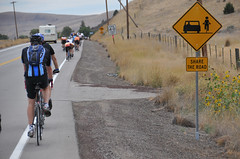
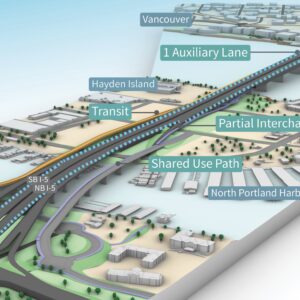
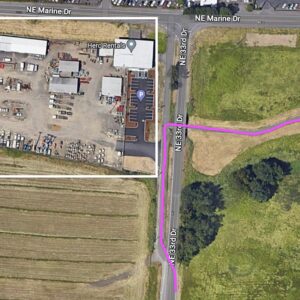
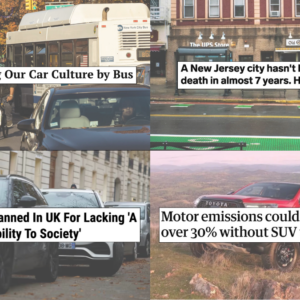

Thanks for reading.
BikePortland has served this community with independent community journalism since 2005. We rely on subscriptions from readers like you to survive. Your financial support is vital in keeping this valuable resource alive and well.
Please subscribe today to strengthen and expand our work.
this is good news since Ray LaHood says that all government transportation money needs to consider bicycles…
and yes, please give a way to quickly bypass the crawl through Newburg/Dundee… bikes can still cut quickly through, but for cars that place is a blight…
Different idea: massively expand rail (freight and passenger) service, and give the highways over to bikes completely. Now that sounds like a transportation plan for the future.
Is someone chooses to live in remote areas and drive to the city each day, Newburg/Dundee, then they should expect a long drive. You can’t have both without crapping on the areas you pass on your way to work. As a culture we already pay way to much for such an unsustainable lifestyle. Let them sit in traffic. Maybe one day they will decide living so far out is not such a good idea.
Ugh !
This is just the build-out of suburban culture.
Build mcmansians and cookie cutter subdivisions. Obviously then you need giant, unfriendly roads that impede anyone except those in cars.
The hundred and seventy five BILLION dollars and 30K lane miles !
Seems totally unnecessary, old school unsustainable “planning”. Good thing they are throwing crumbs to the cyclists.
“AASHTO (is)… calling for 30,000 new highway lane miles”
I hope someone drives a stake through the heart of this insane monstrosity. Or is it monstrous insanity? Anyway, it’s the CRC on wheels, & lots of ’em…
This could be good for bikes simply by mandating that all of the expansion projects require the highway to get a 6′ shoulder on both sides of the road. Right now there are a lot of rural roads in Oregon and elsewhere that have no shoulder, narrow lanes, and high traffic volumes. Compounding this problem, when riding these roads, cyclists are frequently buzzed by high-speed motorists who pass too closely, frequently even when a cyclist takes the lane. Putting shoulders on rural roads that have none would go a long way towards reducing conflicts.
As a perfect example, look at the cyclist death a few years back near Oregon City on 99E (sorry, can’t recall his name) – in a section with no shoulder and restricted clearance.
That said, 30,000 new lane miles kind of sucks to say the least.
I think some of you are overstating the impact of the capacity increase called for. 30,000 lane-miles, assuming one new lane per direction, is a total of 15,000 miles of widening. That may seem like a lot, but when you consider that JUST THE PRIMARY ROUTES…the Interstates and the major corridors that are on the National Highway System (NHS) in the lower 48 total over 160,000 miles (to say nothing about the rest of the state highway systems or lower-level roads), it’s really not a large amount of widening in the grand scheme of things.
Everyone focuses on the lane widening, when there’s a lot of language also calling for bridge improvements and shoulders. The shoulders in particular would be a boon to rural bicyclists.
I sure hope they come up with a plan getting really worried riding on roads that end on me. If anyone is out near Wilsonville you will notice Wilsonville RD is a huge cut thru road now for the Newberg and other ppl that dont want I-5 traffic.
Lots of formerly quiest agricultural roads in the area are now high speed and busy alternatives for drivers who don’t like the highways designed for them. Like some of the roads out near North Plains. So, even though they have the (nonexistent) shoulder and bad sight lines of a great farm road, they have the speed and traffic of a thru road. With a smooth shoulder (also known as a bike lane), one can at least ride without getting passed by cars who try to split the lane.
SPACE on the roads would be great. Another 30,000 miles of car lanes. . . that’d just create more traffic. How about improvements like the dividers that they put up on US 26 out toward Mt Hood? Improve the roads, don’t just make them bigger.
#9 right on so true. On these nice roads ppl yell at me all the time saying that I ride with a target in my head, Think for once they could slow down? Have Hummers and ppl with boat trailers just flying to get to the water. Sick! I Worry about getting hit from behind. Oregon like any other State can be for the most part carless in spots but ppl too lazy and make excuses for change.
If the impetus is rural and agricultural travel I suggest that these old country roads be expanded but not in the way the auto drivers think.
Make slow vehicle lanes on both sides of these simple two lane country drag strips and make them the width of a combine.
Cyclists, farm implements and other slow movers then would have no need to try and share the road with aggressive country drivers.
I wouldn’t get too excited either way. AASHTO is dreaming given the current economy. The gas tax and the accompanying highway trust fund has withered over the years due to inflation and cars getting better gas mileage. Electric cars will pay zero in gas taxes.
AASHTO are hoping for another stimulus package, but that seems pretty far-fetched given the current political environment.
Cyclists should worry more about the proliferation of rumble strips eating into the paved shoulders that are available today rather than dreaming of new ones.
Crazy talk. Is anybody really thinking about climate impacts? Petroleum use? Wider shoulders just mean easy road expansion in the future. They are rarely designed for safe or smooth cycling.
They should be looking at separated grade bike paths. The type of work required would put more people to work becuase you can’t use those huge machines to work in smaller spaces that work fine for bike paths.
I am confused. The project in southern Oregon is for truck climbing lanes on I5. One is already under construction. How is it that this would help bicycles?
First of all I would like to say I admire anyone who is willing to give up their vehicle for a bicycle as a way of transporation. You are making a decision to be more healthy and saving the environment.
What I would really like to comment on is where do you all think the money comes from to build this extra bit of pavement for you to safely travel on? The transportation fund is based on gas taxes. Who pays gas taxes? People who drive cars. What makes you think someone paying gas taxes for improvements to a roadway wants to spend extra so they can share the road with a cyclist. Do you have any idea how much 6 extra feet of pavement costs after 30,000 miles? That money could be used for some other roadway improvement for automobiles and there is plenty of them since vehicles are getting more and more fuel efficent and less and less money is raised from the gas taxes.
As I said before, I admire cyclists and I wish I had the confidence to be one but I won’t risk my life to do so nor will I hold my breathe for an actual bicycle lane to ever be constructed with roadway money paid by gasoline taxes. What needs to happen is a completly different tax, fund, bond whatever it may be just for cyclists. If you want your own lane you’re just going to have to pay for it yourselves. Then I would be more inclined to be a cyclist and therefore help pay for it too.
“…(AASHTO) — an influential group of state DOT directors — announced a report calling on Congress to prioritize funding for expanded rural highway capacity in the forthcoming re-write of the transportation bill. …” maus/bikeportland
Protecting high quality of rural and other even more natural areas is important. High numbers of fast moving motor vehicle traffic has the regrettable effect of degrading that quality. In Washington County, off Scholls Ferry Road, Roy Rodgers Rd to Six Corners/Sherwood is an example of this.
The Newberg-Dundee bypass would be a great idea…but not from the standpoint of its potential for increasing motor vehicle movement capability…a mode of travel which needs to be restrained. What should be seen as the primary benefit of that bypass, is its potential to reverse the degradation of those towns livability that’s occurred through abuse of their main streets as a pass through to points beyond.
Within the tri-county area, any expansion of roads and highways probably should specifically be in the area of bike lanes and pedestrian walking routes, deliberately choosing not to support greater volumes of motor vehicle usage.
Highway 47 south of Forest Grove, has a superb road shoulder…Didn’t measure, but it seems about 6′ wide. The roads of towns and cities within the metro area, equipped with shoulders such as Highway 47 has would be a major improvement in support of people’s ability to independently travel, without counter productively enabling more motor vehicle use of the roads.
170th between Tualitan Valley Hwy and Baseline Rd, out in Beaverton is an example of a road whose expansion is likely imminent. Currently and for decades past, it’s been a two lane (probably 12′-13′ lane width) north-south connector country road, without shoulders (mostly so…within perhaps the last 10 years short sections of not continuous bike lane have been installed).
Despite not having shoulders, it was always a fairly easy road to ride by bike, until recent years as motor vehicle use of the road increased to the point where during rush hour, it can be extremely difficult to cross the road, or even enter the road from side streets. Logically, it figures that various officials and planners have been thinking of expanding vehicle capacity on this road, and at some point, will suggest doubling this roads width making it two lanes (that is…motor vehicle lanes) in each direction. The road thus expanded could easily become another loud, dirty, dangerous, and stressful road such as Tualitan Valley Highway.
Wow, this sounds familiar. Don’t believe what we DID for 60 years straight, believe what we SAY we’ll do…
Not buying it. AASHTO is a tool of the auto/trucking/petro/roadbuilding lobbies. They couldn’t care less how many cyclists/drivers/people are run over in the process.
Sarah, get real. The gas tax only accounts for around 2%-4% of transportation funds. The rest comes from variety of general funds, ie. all citizens pay.
Unit: so what you’re saying is that the state DOT’s are “tools of the auto/trucking/petro/roadbuilding lobbies, since it’s the state DOTs that make up AASHTO’s membership.
Lance: not entirely true. Two recent transfusions notwithstanding, 100% of Federal highway/transit funding comes from the gas tax. At the state and moreso local levels is where your percentage drops. Not sure what the various state gas taxes bring in, but the Federal gas tax accounts for roughly 15% (give or take a few) of transportation funds nationwide.
Lance, I’m as real as it gets. I’ve heard this argument over and over and nothing gets done about it. True, all citizens pay but that percentage of taxes, bonds, grants, etc is based off of a 12 ft lane with maybe a 2 ft shoulder. You want an extra 4 feet on that shoulder you need to come up with your own funds. Get as creative as you want. A license for cyclists, an extra tax on bicycles, whatever it takes to separate bicycle funding from automobile funding. Even the funding for roadways is starting to get creative from tollways to a “pay as you go” system to where they tax you based off of number of miles driven (replacing the gas tax). If you want this to become a reality then awareness needs to be raised. Quit waiting for AASHTO and/or the DOT because you’ll be waiting forever. Funny how everyone wants improvements but nobody wants to pay.
Getting that 4′ isn’t always as difficult or expensive as it might seem. One way to do it, is to convert one of the travel lanes on a multiple lane roadway primarily devoted to motor vehicle use, into exclusive use by pedestrians and people that travel by bike.
Compared to adding a 4′ or wider shoulder to both sides of a road, this approach costs far less, is still paid for by property taxes, helps reduce excess motor vehicle usage, pollution, noise, neighborhood livability degradation and sprawl.
Ah yes, the “road diet”. Which is workable in an urban or town area…not so much in a rural area.
Furthermore, there’s an upper limit as to the traffic level you can do such a change width…studies suggest that upper traffic limit is about 20K ADT. Below that is fine (especially below 15K). Above that, you create more problems than you solve.
In #15 comment above Sarah repeats one of the biggest myths in the USA, to wit: Highways are paid for by gas taxes paid at the pump. I do believe that nationwide less than 40% of true actual road building, maintenance and repair is covered by taxes paid when a motorist buy petroleum at the pump. A small amount comes from tag fees and the rest comes from the general tax coffers. Check it out!
Jose, you can’t really explain a blanket percentage of xx% nationwide for two reasons: first, many roads (especially neighborhood streets) include bike lanes, sidewalks, multimodal stuff, etc etc. Secondly, there’s the vast range of jurisdictional responsibility, from local town/township all the way up to Federal. ‘Tis better to break it down in the latter method.
The vast bulk of “general tax coffers” for roads comes at the local and county level. As you go up the hierarchy, the percentage of funding coming from vehicle/gas-related taxes increases. Some states get 100% of their road funding from road-related taxes…other’s don’t. And until recently, with the HTF balance problems and Congress’s “solution” of transferring $8 billion from the general treasury to the HTF, 100% of Federal highway (and transit too) funding came from road-related taxes.